Chakri Day (April 6) was first instituted by H.M. King Vajiravudh (Rama VI) in the year 1919 to commemorate all the Kings in the Chakri Dynasty, which started with Rama I and continues to this day with Rama IX, H.M. King Bhumibol Adulyadej the Great.
The reigning Kings in the House of Chakri brought peace and tranquility to the people within Thailand’s borders and successfully protected the Kingdom, maintaining sovereignty and integrity through crucial periods threatened by European colonization and two World Wars.
In commemorating Chakri Day the national flag is proudly displayed by the people of Thailand and all government officials and members of the community participate in traditional ceremonies, making offerings of flowers and garlands at the many statues of Kings in the House of Chakri.
The Chakri Dynasty, or the “House of Chakri” followed the reign of King Taksin the Great, when He abdicated due to poor health. The Chakri Dynasty was ushered in on 6 April 1782 when a close aid of King Taksin, General Chakri, marched back into Thonburi and assumed the throne as H.M. King Buddha Yod Fa Chulalok the Great (Rama I). Each Monarch thereafter has had “Rama” as part of their title.
Banks, government offices and most business offices are closed on Wednesday, April 6 in observance of this special day.
Chakri Dynasty – Chronology of the present-day Dynasty of Thailand
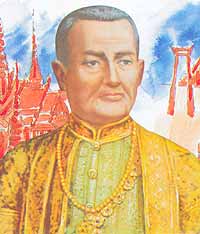 King Buddha Yod Fa Chulalok the Great (Rama I) 1782-1809
King Buddha Yod Fa Chulalok the Great (Rama I) 1782-1809
King Buddha Yod Fa Chulalok the Great was chosen King in 1782, becoming the founder and first ruler of the House of Chakri. During the year of his accession to the throne he moved the capital from Thonburi to the opposite bank of the Chao Phraya River, thus founding the city of Bangkok. It was during his reign that the Grand Palace was constructed and he installed the Emerald Buddha in the Chapel Royal following its completion. Many historians have stated that modern Siam dates from his reign.
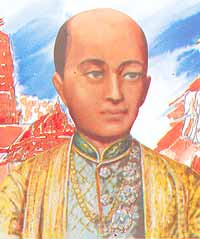 King Buddha Loet La Nabhalai (Rama II) 1809-1824
King Buddha Loet La Nabhalai (Rama II) 1809-1824
King Buddha Loet La Nabhalai (Rama II) was the only Maha Uparaja (Deputy King, appointed by his father King Rama I in 1806) to eventually succeed to the throne during the period of the Chakri Dynasty. His reign was a period of consolidating the achievements of the previous reign and he began the custom of appointing senior princes to supervise over the different departments of state. He is best remembered, though, for his interest in the arts. He was an artist, writer and composer, and the arts flourished during his reign.
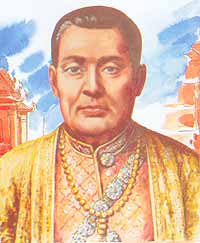 King Nang Klao (Rama III) 1824-1851
King Nang Klao (Rama III) 1824-1851
During King Nang Klao’s reign trade prospered and territorial advances were made as the vassal states of the north and east came more firmly under the rule of Bangkok. During his rule, in 1833, the first treaty with the United States was signed. Extensively encouraged international trading and education, enhanced promotion of Buddhism and built many temples.
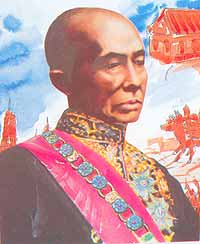 His Majesty King Mongkut (Rama IV) 1851-1868
His Majesty King Mongkut (Rama IV) 1851-1868
Modernized Thailand in both commerce and education, and instituted reforms which would adapt the country to western ways. Known as the “Father of Thai Scientists”, he was famous for his astrology. Before becoming King, the then Prince Mongkut entered the monkhood. Ironically, it was this period in monkhood, which required him to take a vow of poverty and self-denial, that gave Prince Mongkut a good understanding of statecraft. It allowed him to meet people from all walks of life, from the humblest to the elite, Thais as well as foreigners. He traveled to various parts of the Kingdom, barefoot, depending on offerings of food and other necessities from the people. From the Thais, he gained an invaluable first-hand insight into their welfare and livelihood. From the foreigners, he obtained precious information about the outside world, especially about technology and science.
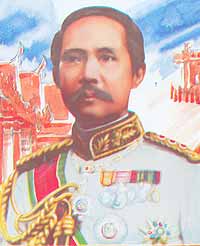 King Chulalongkorn the Great (Rama V) 1868-1910
King Chulalongkorn the Great (Rama V) 1868-1910
King Chulalongkorn the Great is one of the most beloved and revered of all the Chakri Kings – during his long reign of 42 years 23 days great advances were achieved for the country. He abolished slavery, extensively contacted the Western world, modernized the government, education, transportation, and communication. Bonds of friendship between himself and the various European royal families were formed which exist to the present day. He successfully managed to cultivate the idea of Siam as a buffer state between the colonial possessions of the European powers in South-East Asia. The price he paid of losing certain border territories was amply rewarded, for Siam was never colonized – the only country in the region to maintain its sovereignty throughout the period of colonial expansionism.
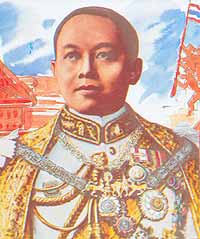 King Vajiravudh (Rama VI) 1910-1925
King Vajiravudh (Rama VI) 1910-1925
King Vajiravudh was educated in England and his great love of literature and poetry in both Thai and English together with his scholastic abilities was later to manifest itself during his reign. Among his lasting achievements were devising a system of transliteration of Thai into English and of translating the entire works of Shakespeare into Thai. His passion for traditional Thai theater and ballet has left a mass of published scores which form the basis of the study of these arts to the present day. He continued the work of Rama V in modernizing Thailand, promoted education and established the Boy Scouts in Thailand.
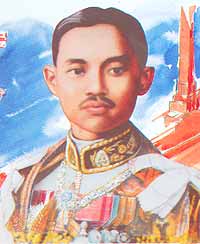 King Prajadhipok (Rama VII) 1925-1935
King Prajadhipok (Rama VII) 1925-1935
King Prajadhipok’s reign coincided with the worldwide economic depression which followed the Wall Street Crash of 1929 and its effects were not unfelt in Siam. On April 6, 1932 the country celebrated the sesquicentenary of the Chakri Dynasty – two months later the eventual transferal of power to a Legislative Assembly began. On December 10, 1932 King Prajadhipok granted a constitution to the Thai people, and the Constitutional Monarchy of the present day was born.
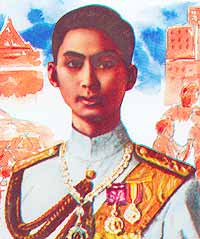 King Ananda Mahidol (Rama VIII),1935-1946
King Ananda Mahidol (Rama VIII),1935-1946
A direct grandson of King Rama V, King Ananda Mahidol was the eldest son and second child of H.R.H. Prince Mahidol Adulyadej, Prince of Songkla. He succeeded his uncle, King Prajadhipok, as King on March 2, 1935.
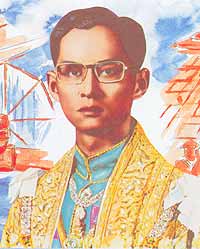 King Bhumibol Adulyadej the Great (Rama IX) 1946 to the present
King Bhumibol Adulyadej the Great (Rama IX) 1946 to the present
A true monarch of the people and guiding light for the whole Thai nation. Saved Thailand from many crises, dedicated to raising the living standards of the poor, especially in remote regions. As his reign advances, the growing reverence of the Thai people for their sovereign has become ever more apparent. On May 5, 1987, to mark his then forthcoming 60th birthday, King Bhumibol Adulyadej was proclaimed “the Great”. On July 2, 1988, HM King Bhumibol Adulyadej the Great celebrated his record reign – the day on which he had reigned longer than any of his predecessors. To this day, he remains the longest reigning monarch in the world.




